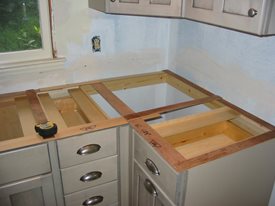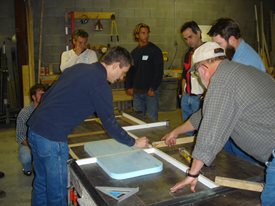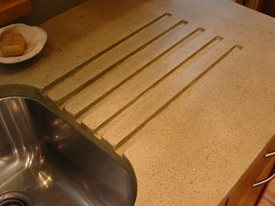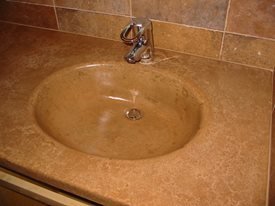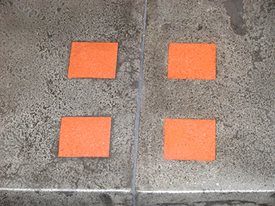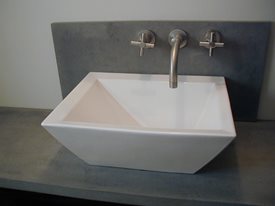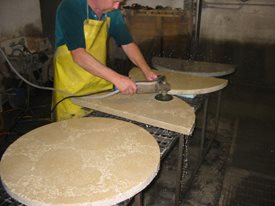A-C | D-F | G-I | J-P | Q-T | U-W
The concrete industry covers a broad range of people who design, use, apply, and build with concrete. Whether it is a concrete contractor, a manufacturer, an architect, designer, homeowner, builder, or supplier, it benefits everyone to have a general understanding of terms used within the industry. The Concrete Countertop Institute, located in Raleigh, NC provides this glossary of the most commonly used concrete countertop terms and definitions.
A
acrylic sealer - A simple, single-component polymer that is either water-based or solvent- based. Provides moderate stain protection and is easily scratched.
A-frame - An A-shaped wooden or metal framework used to transport countertop slabs on edge in a truck.
apron front sink - A sink that has a large apron in front and sits on a short cabinet; sometimes called a farmhouse sink.
B
beam - A horizontal structural member often supported near the ends and spans an open space. Concrete countertops are beams, even if there is plywood underneath them, because plywood is too weak and flexible to provide enough structural support to the concrete to prevent cracking.
bugholes - Small voids in concrete caused by entrapped air bubbles. Generally there should be no bugholes on the top surface of concrete countertops, especially for kitchen counters.
C
cantilever - A beam that projects beyond its supports. An area where a countertop overhangs a cabinet or support by more than a few inches.
casting table - A strong, level table designed for casting concrete slabs on top of it
caulk - Used to fill seams between countertop slabs. Usually color-matched. Made of a flexible material such as acrylic, so that they create control joints in the concrete.
compressive strength - The ability of concrete to resist compression forces, or pushing together forces, expressed in pounds per square inch (psi)
concrete countertops - A handcrafted alternative to manufactured countertop surfaces. Can be precast in a shop in molds built to the customer's specifications or cast in place, by setting a form on top of the base kitchen cabinets and then filling with concrete. The use of stains, dyes, pigments, decorative aggregates, and epoxy coatings can give concrete countertops the look, texture, and feel of quarried stone such as marble, granite, and limestone.
control (or contraction) joint - Sawed or tooled groove in a concrete slab used to regulate the location of cracking.
cooktop - A self-rimming assembly of stove burners that fits into the countertop
D
drain board - Grooves or depressions in a countertop next to an undermount sink which allows water to run into the sink.
drop-in sink - A sink that has a rim that fits over the countertop, also known as top-mount or self-rimming.
E
edge return - A countertop edge that is thicker than the rest of the slab, to give the appearance of a thicker slab
epoxy sealer - A 2-component system that reacts when mixed to form a hard, durable sealer. Can be UV sensitive and are not heat resistant. Tends to be shiny, thick and look like plastic.
F
fibers - Tiny filaments made of polypropylene, polyolefin, nylon, polyethylene, polyester, or acrylic used to control shrinkage cracking. Fibers do not provide structural reinforcement.
film-forming sealer - A type of sealer that blocks the penetration of water and contaminants by forming a barrier on the concrete surface. May also impart a gloss or sheen, which enhances colored or exposed aggregate concrete.
G
grinding - A mechanical surface preparation method using rotating abrasive stones or discs to remove thin coatings and mastics or slight flaws and protrusions.
grout (slurry) - A cement paste used to fill bugholes in countertops.
I
install - To set a countertop onto cabinets and caulk any seams so that the countertop fits well, is level, adjacent slabs are flush, and all fixtures such as sinks and faucets are properly mounted.
integral sink - A sink made out of the same material as the countertop and forms a continuous surface with the countertop.
K
knockout - A rubber or foam shape placed in a form where there will be a hole in the countertop
M
melamine - Particle board coated with a plastic material. Often used in forming concrete countertops because of its smoothness and easy release
metakaolin - Refined kaolin clay that is fired (calcined) under carefully controlled conditions to create an amorphous aluminosilicate pozzolan that consumes calcium hydroxide (lime) byproducts produced during cement hydration, resulting in increased compressive strength due to decreased lime content. Used as a 10% to 20% replacement for cement.
microspheres/cenospheres - Very fine, lightweight hollow ceramic spheres that are chemically identical to fly ash but too large to offer any significant pozzolanic reactivity. Used as a replacement for sand for lightweight concrete or to modify the consistency of the concrete, making it stiffer and less sticky.
mortar mixer - A mechanical mixer designed for blending cement based mortar. Mortar mixers use rotating paddles attached to a horizontal axle to mix mortar or concrete. Often mortar mixers are used for mixing the small batches of concrete required for concrete countertops.
P
penetrating sealer - A sealer with the ability to penetrate into the concrete surface to increase water repellency and resist stains. Often used on decorative concrete to provide invisible protection without changing the surface appearance.
pigment - A finely ground natural or synthetic particle adding color and opacity to a coating or topping.
plastic shrinkage cracks - Irregular cracks that occur in the surface of fresh concrete soon after it is placed and while it is still plastic.
primary reinforcement - Structural reinforcement designed to carry tension forces in reinforced concrete. Often steel rebar or carbon fiber is used as primary reinforcement. Choice of material, amount and correct placement are critical to obtaining the desired structural characteristics.
R
rebar (or reinforcing bars) - Ribbed steel bars installed in cast-in-place or precast concrete as primary reinforcement to provide flexural strength. Rebar come in various diameters and strength grades.
reinforced concrete - A structural composite of concrete with embedded tendons designed to carry tensile loads. In reinforced concrete, the concrete itself carries compressive forces while the primary reinforcing carries tensile forces. The addition of reinforcement transforms a brittle, low tensile strength material into a strong, ductile material.
S
sealer - Solvent- or liquid-based material used to protect and enhance the appearance of decorative concrete. (Also see film-forming sealer and penetrating sealer.)
seam - A joint between 2 adjacent slabs of countertop material. Seams function as control joints in brittle materials such as granite or concrete.
secondary reinforcement - non-structural reinforcement designed to control shrinkage cracking. Often welded wire mesh and/or fibers are used as secondary reinforcement in slabs.
shim - Used during installation to insure that adjacent countertop slabs are flush and level.
shrinkage - The tendency of the cement paste in concrete to shrink as it cures, causing concrete slabs to either curl (due to unrestrained shrinkage) or crack (due to restrained shrinkage)
Using Countertop Template Materials
Time: 01:49
Learn the basic use of this tool and why these strips are used instead of using a measuring tape.
slab on grade - A concrete slab that is fully and evenly supported by an substrate such as the ground. Sidewalks are slabs on grade.
superplasticizer - High-range water reducer (30% and above water reduction)
T
tensile strength - The ability of concrete to resist tension forces, or pulling apart forces, expressed in pounds per square inch (psi).
template - A physical pattern that represents the space into which a countertop will fit. For precast concrete countertops, templates are created on the finished cabinets, then the templates are used to determine the size of the forms.
U
undermount sink - A sink that is mounted underneath the countertop.
urethane - A type of sealer that provides good stain, heat and scratch resistance but is difficult to apply properly and can debond if the concrete surface is not properly prepared.
V
vessel sink - A sink that sits on top of the countertop.
W
water reducer - An admixture that either increases the slump of freshly mixed concrete without increasing water content or maintains workability with a reduced amount of water without affecting the strength.
wax - Applied to concrete countertops as a "sacrificial protectant", meaning that it provides a small amount of protection against stains but wears away quickly and must be reapplied often
welded wire mesh - A woven mesh of wire strands, welded at each intersection, commonly used as secondary reinforcement in concrete slabs to control shrinkage cracking. Also called welded wire fabric. Does not provide primary structural reinforcement.
wet polishing - A method for polished concrete that uses water to cool the diamond abrasives and eliminate grinding dust. The process creates a tremendous amount of slurry (a soupy mixture of water and cement dust) that must be collected and disposed of.
white cement - A portland cement with a low iron content that hydrates to a white paste. Often used in integrally colored concrete to produce pure, bright color tones, especially pastels.
